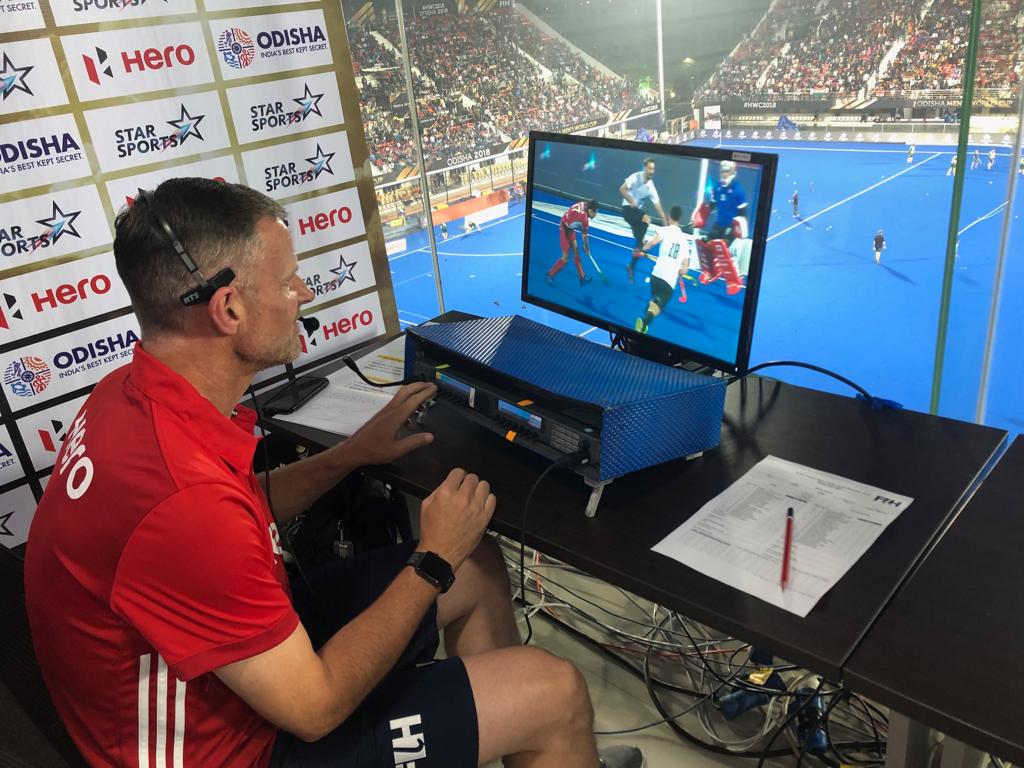Climbing the ladder

Put your hand up if you’ve ever been confused by umpire gradings or levels? I know I certainly have!
Maybe you’re a budding umpire looking to tackle the national pathway or you’re an umpire coach looking to educate the umpires you’re mentoring. You might be an umpire manager wondering what you should be looking for to recommend people to the next level or a top-level umpire looking to take the next step towards your international career. Maybe you’re just interested to know which umpires can be appointed to which tournaments? Or maybe you’re just wondering what the heck is going on… *raises hand*
Maybe you have questions like:
- What levels are there?
- What do you need to climb the ladder to the next level?
- What are people looking for performance-wise at each level?
All valid questions let me assure you. I’m going to break it down in this post for you so you don’t feel like you’re trying to find a flashlight in a dark room, inevitably blundering into every inanimate object in that damn room because you’re the most uncoordinated person ever. Or is that just me? Never mind then…
If you’re wanting to know about the international pathway, check out this post on the new FIH umpiring pathway. The first time I learnt about the international tier grading was during a tournament in Fiji (life’s tough sometimes…) where I met Karen Bennett, an international umpire from New Zealand who was working her way up the rankings, who would later go on to umpire at the 2014 World Cup. I knew there was an international badge, and of course I assumed that the best umpires get appointed to the Olympics and so on, but I didn’t realise just how the system worked. It was at that tournament that my dream of an international career was awoken.
But first, let me offer you some tips that apply to ALL the levels:
- It’s not just your on-field performance that will be taken into consideration; your behaviour off the field also matters. Have a great attitude, always support your teammates, and never compromise your integrity. Not just because you want to be promoted, but because you’re a nice person. Obviously.
- Are you coachable? You need to be able to take feedback on board. Your umpire coach will let you know when you got something wrong and you need to be able to accept this criticism and learn from it. They will also ask you to try things and you need to be willing to implement this in your game to see if it works for you.
- Make sure your fitness is up to the standard required for the appropriate level. You need to make sure you can keep up with the play and that you can handle the physical load during a tournament.
(Have a look at the fitness section of this page to help you out with this – from nailing your fitness test and improving your fitness, to what to eat before and after a match).
So, let’s delve deeper into how the umpiring pathway works…
Pre-warning: Buckle up! This one’s a long one. It had to be to contain all the information. Feel free to only read the part that applies to you and come back for a refresher later when you’ve got time, or you’re at the next level. Or read the whole damn thing because it’s super interesting and SUPERBLY written (why thank you, so kind of you to say!).
DISCLAIMERS:
Just before we get started, obviously these tips should be used as guidelines. Nailing these things isn’t guaranteed to get you promoted, but it will go a long way. There will often be other factors at play that determine whether you climb the ladder (or if you are ready for a promotion). These will often be outside your control – sometimes other life events get in the way, sometimes you’ll have to return to a level to share your experience or consolidate your skills, or sometimes you’ll have to wait your turn if the higher panel is already full. And sometimes you might just have reached your highest potential – and that’s ok! Celebrate your success and what you’ve achieved.
I also feel it’s necessary to point out here that every national association will obviously structure their national tiers differently, however the basic advice is the same. If your country doesn’t have some of the levels mentioned below, group the advice of the tiers together. Or if your age-levels are slightly different, go with the closest age bracket or equivalent tier.
Climbing the ladder: The Ultimate Guide to Umpire Gradings
So what are these levels and what do you need to show to move through them?
The National Pathway
Most national leagues will start with underage/junior competitions and this is the entry point into the pathway for all umpires wanting to progress through the ranks. Demonstrating you’ve got the moves will allow you to pass Go, collect $200 (of Monopoly money, not real-life money… soz), and move on to round 2 where the difficulty level gets clicked up a notch.
There’s in-depth information below, but here’s a handy summary of what you need to know if you can’t be bothered reading everything (WHHOOOO, COLOURS!!!):

Under 12/13
To attend the entry-level tournament, your state/regional association needs to recommend you to your national association. You should be umpiring your local junior level games at U13-15 level (and maybe some lower senior level games every now and then, although it’s ok if you’re not yet). You might even have umpired at a regional level junior carnival or championship, which is great! Make sure you’re getting some coaching, and that someone from your state or regional association has come out to assess you so that they can recommend you to the national association for a tournament.
To do well at U12/13 level you need to:
- Have a basic idea of positioning
- Know when to blow the whistle (and make it loud enough!)
- Know all the signals and use them
- Have a good, basic knowledge of the rules
- Be competent umpiring at U12/13 level
Under 15
Congratulations! You’ve made it to the next step. You should be umpiring the U15 equivalent level in your home association and some lower level senior matches. Here, you need to show:
- Basic recognition of technical infringements – stick sounds vs. infringements
- You can use your whistle effectively – whistle tone and variation (see this article about how to blow your whistle)
- Good positioning – being in the right place to make accurate decisions
- That you are trying to give advantage
- You’re competent at umpiring U15 level
Under 18
By now things are starting to get a bit more serious. You should be umpiring the highest level junior games in your local association and some high level senior games.
You need to show:
- A sound knowledge of the rules, with consistent and accurate decision making
- Basic management ability – experimenting with your ‘management tool box’
- That you are starting to differentiate between professional fouls and accidents
- That you understand how the game flows – you are able to allow advantage
Under 21
It’s serious business at U21 level (but remember to still have fun!). This is often referred to as the ‘make-or-break’ level – there’s only one level higher, and because it’s open age there is normally a bottle-neck of top-level and international-level umpires there. This means that there are not usually many places available for promotion from U21’s, and many umpires find it difficult to get promoted from this level, so try not to be too hard on yourself! You may have to return to this level a few times in order to prove yourself, you may have to wait until a spot becomes available in order to be promoted, or you may not get promoted from this level – if this is the case, it certainly doesn’t mean that it’s the end of your umpiring career! You should also be super proud of yourself. You made it to the top level of the underage pathway, that’s nothing to sneeze at!
To perform well here you should be umpiring top level games in your local association regularly (premier league, state league, A-grade, etc.).
To have a chance of getting a promotion to open-age level, you need to prove you:
- Have a thorough knowledge of the rules and good positioning
- Have good management skills – you work through your umpiring toolbox in order to manage complex situations
- Perform well in pressure situations
- Understand what the players are trying to accomplish – professional vs. accidental fouls, personal vs. team penalties, appropriate actions and penalties depending on foul, impact on game and pitch location
- Demonstrate understanding of game flow – when to intervene (quick free hit vs. play-on advantage, coming back to personal fouls, etc.)
- Have presence on the field – confidence, calm persona, individual flair, good presentation
National League (open age)
Congratulations on making it to the big league! All your hard work is paying off! Not many people make it to this level – you’re one of the lucky ones and you should treasure the opportunity you’ve been given!
Performing well at national league is about experience – both at national league and in your local association. You should try to get as many challenging games under your belt as possible, and this may take time. You need experience in tough games requiring lots of management (top of the table and bottom of the table clashes, grudge matches, high-stakes games such as determining who makes finals or not, and finals games themselves, etc.).
You’ll need to demonstrate:
- Real understanding of the game
- Advanced management skills – including strength and empathy when dealing with players and coaches
- Ability to handle tough games
- Technical appreciation of the rules
- Consistency and accuracy in decision making and positioning
- Individual flair and confidence
- Advanced understanding of game flow, advantage and whistle timing – when to intervene, when to come back to a foul, possession vs. quick free, etc.)
Taking the step to International…
The next step up from your national league is to go for your international badge. A lot of factors come in to play for this step – you need to have the potential for an international career and you need to work hard, be patient and, to a certain extent, be lucky. You need to umpire a minimum of 3 FIH sanctioned international games to be considered for your badge. These need to either be senior international games or high-level U21 internationals. There needs to either be an FIH appointed TD/UM (i.e. at a 4 Nations tournament) or a neutral FIH assessor present (if you are umpiring your own country in a test series).
There’s more information on the pathway in my post about the new FIH umpiring pathway, or on the FIH website if you’re interested.

Dream it, live it.
So I hope that’s cleared up for you exactly what the pathway levels are for both National and International progression, and what you need to do to climb the ladder to achieve your dream! Go get ’em, tiger!
Hopefully this gives you the pointers to work on before you go away to your tournament so that you can do really well – but remember, these are just guidelines and there may be other factors to consider too. I hope this has also given you the knowledge you need to go and educate and motivate the up-and-coming umpires in your association to dream big and achieve great things!
Did you find this helpful? Or do you think I missed anything out? Let me know in the comments below, and remember to share it around! You can send the link via email to all your friends, or share it on social media using the buttons below! And don’t forget to sign up to the newsletter to get new posts delivered straight to your inbox 🙂
For some behind the scenes action and extra tips and tricks, follow me on Facebook and Instagram.




You must be logged in to post a comment.